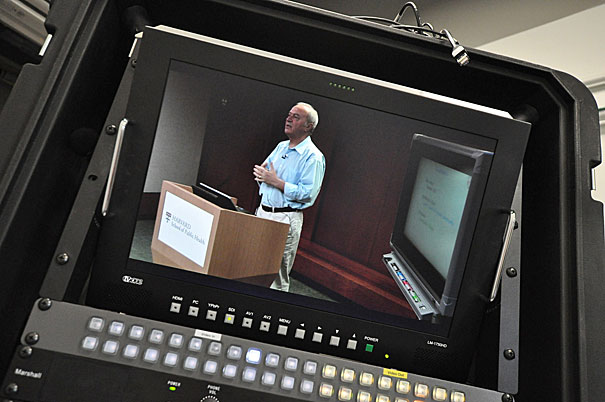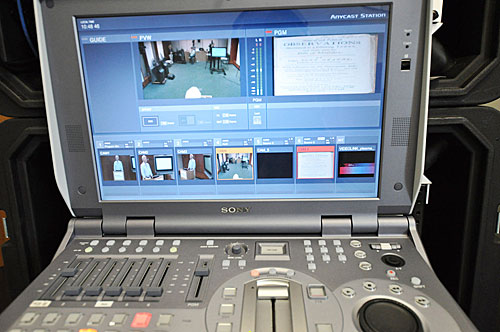
“I figure I’d have to teach another 200 years to reach that many students in person,” said Harvard Professor Marcello Pagano (pictured), after learning that more than 100,000 people worldwide had signed up for the two Harvard courses being taught on the edX platform.
Photos by Aubrey LaMedica/Harvard School of Public Health
HarvardX marks the spot
University launches two online courses, and more than 100,000 sign up worldwide
Harvard University’s first two courses on the new digital education platform edX launched this week, as more than 100,000 learners worldwide began taking dynamic online versions of CS50, the College’s popular introductory computer science class, and PH207, a Harvard School of Public Health course in epidemiology and biostatistics.
For Marcello Pagano, a professor of statistical computing who is co-teaching PH207x, the potential to teach so many students at once is amazing.
“I figure I’d have to teach another 200 years to reach that many students in person,” he said.
In May, Harvard and the Massachusetts Institute of Technology (MIT) announced the launch of the not-for-profit educational enterprise edX, which features learning designed specifically for interactive study via the Web. Since then, Harvard has established HarvardX, the University-based organization that supports Harvard faculty as they develop content for the edX platform. In the past six months, a leadership team has formed, faculty and research committees have launched, and courses have been developed.
Although online courses have been around for years, the professors working with the platform say that HarvardX forces them to get creative about crafting more-active learning environments.
Rather than just broadcasting full lectures on the Internet, the HarvardX classes incorporate short video-lesson segments, along with embedded quizzes, immediate feedback, student-ranked questions and answers, online laboratories, and student-paced learning. Certificates of mastery will be available for those motivated and able to demonstrate their knowledge of the course material.
“This is the future,” Pagano said. “What you have in classrooms today, I think of as a play. What we have now, with HarvardX, is the movie. You can swap out scenes, edit, perfect it. This is the way we communicate now. When you want to know how your friend is, do you go and visit them in person? No, you send a text. We are getting away from the ‘come to me’ model.”
In Pagano’s eyes, the beauty of the HarvardX platform is that students can move along at their own pace.
“They can stop a lecture in the middle and ponder a concept,” he said. “They can replay if they don’t understand something, and they can speed up when they grasp something quickly. You can’t do that in a lecture hall with 100 students. This is much more individualized.”
For CS50x instructor David Malan, director of educational innovation and manager of pedagogical innovation, being able to produce short videos on key concepts means that students get a more consistent, polished experience than might work in a lecture hall. The library of lectures also liberates him to explore other concepts and go more in-depth in his on-campus class.
“I don’t see the lecture or section going away,” he said. “Rather, students can choose the learning process that works best for them, and have the option of exploring other topics even if we don’t have the time to cover them in class.”

But students aren’t the only ones who stand to learn through edX. The platform will provide a trove of data for Harvard and MIT researchers, who will study patterns of student achievement in the hope of making course material and methods more effective for students both on and off campus. Concrete data from large samples will be a lot easier to read than the puzzled expressions an instructor might see in a lecture hall.
“It’s very exciting to have tools to give us insights into patterns of behavior,” Malan said. “The data will allow us to make statistically significant inferences that aren’t always possible with smaller samples.”
Members of the HarvardX leadership team are enthusiastic about the edX partnership’s potential to transform pedagogy in classrooms and living rooms in Massachusetts, across the nation, and around the globe.
“As well as expanding access to high-quality, online learning content for new communities of learners, we believe that edX will strengthen the on-campus learning experience,” said Dean Michael D. Smith of the Faculty of Arts and Sciences (FAS) and a member of the edX board of directors. “For instance, if you sit in the back of a classroom today, you’ll see that students are already using technology to learn. EdX gives faculty the tools to think in new ways about the role technology plays in their teaching and creates new opportunities for research that can form the basis of more effective teaching and learning methods.”
“We view this as an opportunity for us to ask deeper questions about how people learn, and how we as universities help people to learn,” said Harvard Provost Alan M. Garber, also an edX board member.
���[EdX] will provide an unprecedented amount of data on the ways in which students learn,” said Rob Lue, professor of the practice of molecular and cellular biology and faculty leader for HarvardX. “This allows courses to be modified and improved, according to research, and teaches us how to come up with learning experiences that reach the broadest number of students.”
Over the past few months, Lue has met with faculty members at every School to talk about HarvardX and to hear their ideas on how to make the most of this new platform.
“It has been thrilling to meet with my colleagues and hear the wild diversity of ideas that’s out there,” he said. “People have really seized on this.”
HarvardX’s first courses are more quantitative in nature, but Lue said that he looks forward to working with colleagues across Harvard in bringing a wide variety of courses to the platform.
“There is no particular kind of course that we think is the sweet spot for HarvardX,” he said. “I think if we start in that position, it will constrain the diversity of what we can do. I am very excited about the prospect of bringing in courses from arts and humanities, social sciences, and natural sciences.”





